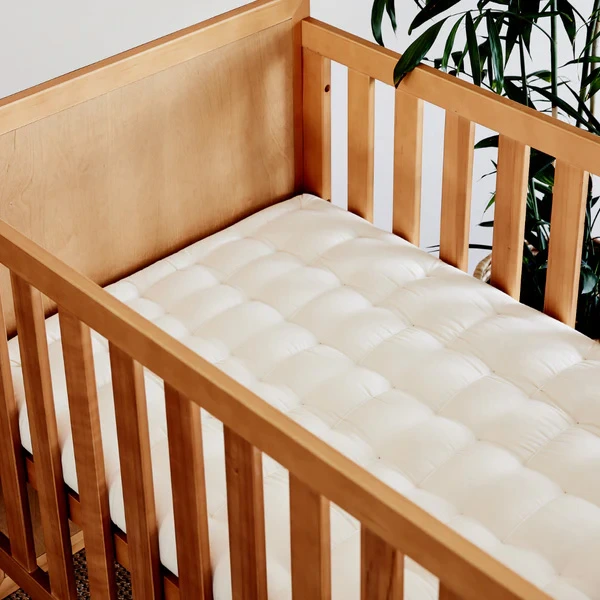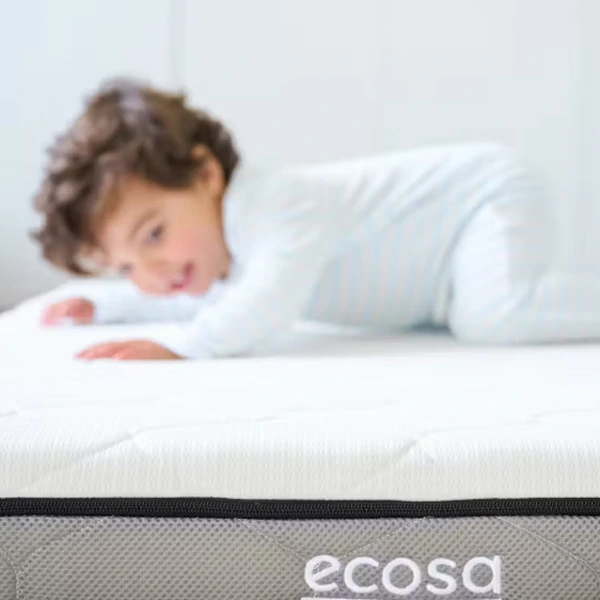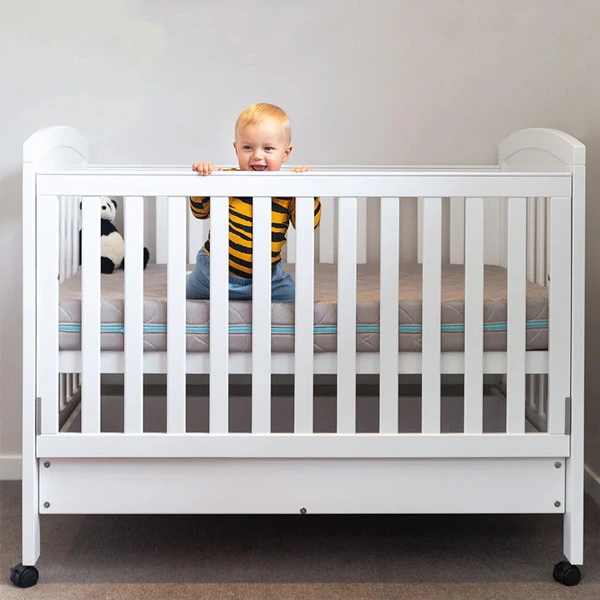Best Cot Mattress in Australia – Which Is Right for Your Baby?
Your baby will spend 16-20 hours sleeping on its mattress each day! This is more time than it will spend in your arms, bouncing in your favourite chair, or even eating. Your choice of cot mattress isn't just about comfort and support; it's your baby's growing space, breathing zone, and safe haven during its most crucial developmental period.
During these extended hours of sleep, your little one's immune system strengthens, bones develop, and respiratory system matures. That's why selecting the best cot mattress is one of the most important decisions when preparing your nursery.
Unfortunately, the Australian market is flooded with confusing options, technical jargon, and misleading marketing claims that complicate this decision. This guide cuts through the noise to focus on what truly matters: safety, quality materials, proper support, and breathability.
Top 6 Best cot mattress in Australia
Quokka Beds
Best OverallOrganic Cot Mattress
This ingenious cot mattress features a dual-sided design crafted from premium organic cotton, wool, natural latex, and coconut fibre. Its tailored support adapts perfectly to each stage of your baby's development while ensuring an utterly non-toxic sleep environment. With exceptional durability and safety, it’s an ideal choice for growing families.
- Cover:Organic Cotton
- Internal Layer:Organic Wool, Organic Latex, Organic Coconut Coir
- Size:Standard Cot
- Certification:GOLS, GOTS, OEKO-TEX, eco-INSTITUT, AS/NZS Standard
The Natural Bedding Company
Prenium Natural Cot Mattress
Handcrafted in Sydney, This Cot Mattress combines premium Australian wool, coconut coir core, and organic cotton/hemp layers (GOTS & OCS certified). It offers exceptional firmness, airflow, and a toxin-free sleep environment. Despite high pricing, this artisanal masterpiece promises enduring quality, ideal for eco-conscious families.
- Cover:Organic Cotton, Organic Hemp
- Internal Layer:Organic Wool, Organic Coconut Coir
- Size:Standard Cot
- Certification:GOLS, GOTS, OEKO-TEX, OCS, AS/NZS Standard
Tasmaneco
Bamboo Pocket Spring Cot Mattress
This Cot Mattress offers a rare, affordable hybrid design, combining individually wrapped springs with natural latex and gel memory foam. The breathable, removable bamboo cover enhances comfort while maintaining airflow. It is perfect for budget-conscious parents seeking natural materials without organic pricing.
- Cover:Bamboo
- Internal Layer:Memory Foam, Natural Latex, Pocket Spring
- Size:4 Cot size options
- Certification:AS/NZS Standard
Organature
Innerspring Organic Baby Mattress
A refreshing traditional approach with certified organic cotton over supportive springs. This allergy-friendly design completely avoids latex and memory foam. With excellent breathability and medium-firm support, this Australian-made, family-crafted mattress provides a non-toxic sleep experience ideal for babies beyond their newborn stage.
- Cover:Organic Cotton
- Internal Layer:Innerspring
- Size:Standard Cot
- Certification:GOTS
Ecosa
Ecosa Cot Mattress
The Ecosa Cot Mattress is designed for modern parents seeking a low-maintenance and durable sleep solution. Available in various sizes, its construction ensures hassle-free cleaning and long-lasting performance. This is the safest synthetic alternative—perfect for those who value practicality without compromising safety.
- Cover:33% Tencel, 67% polyester
- Internal Layer:100% recycled TPEE (Thermoplastic)
- Size:7 Cot size options
- Certification:OEKO-TEX, AS/NZS Standard, Red Nose
Airnest
Breathable Cot Mattress
Designed for ultimate hygiene and breathability, this cot mattress features a washable 'Airnest-Lite' polymer cell construction. Lightweight and highly breathable, it prevents overheating. Made from polypropylene rather than natural materials, it prioritises convenience—ideal for parents seeking easy maintenance over organic composition.
- Cover:Polymer
- Internal Layer:Polypropylene (Thermoplastic)
- Size:5 Cot size options
- Certification:OEKO-TEX, AS/NZS Standard
Cot Mattress Materials: What’s Best for Your Baby?
Feeling lost in the jungle of cot mattresses? That's completely normal - the market has become incredibly complex with marketing jargon designed to confuse rather than clarify. But here's one simple truth every parent should understand: natural is always best, especially for a baby.
Your baby's mattress should provide more than firm support – it should offer a safe and chemical-free environment for their sleep. Not all cot mattress materials are created equal—here are the most common options you'll find in Australian cot mattresses:
Recommended Cot Materials
- Natural Latex: Highly breathable, durable, hypoallergenic, and provides excellent firm support, especially with organic certification. Perfect for temperature regulation and long-term use.
- Coconut Coir: Firm and breathable, provides natural ventilation and exceptional support. Commonly paired with latex or wool for the ideal balance of comfort and firmness.
- Pocket Springs: Offers consistent support and superior airflow (when combined with natural layers), particularly beneficial when combined with natural materials like latex or wool for temperature regulation.
- Cotton, Wool, Hemp: Excellent as comfort layers combined with a supportive core. Naturally breathable, hypoallergenic, and effective at temperature regulation throughout all seasons.
Not Recommendeds
- Polyurethane Foam: While budget-friendly, it often lacks breathability and can emit VOCs (Volatile Organic Compounds). If choosing poly, always ensure it's CertiPUR-certified to minimise risks.
- Polyester: Soft and resistant to stains and spills, commonly used as mattress covers for practical reasons, but significantly less breathable than natural fibres and can emit VOCs.
- New-generation rigid plastics: New-generation rigid plastics (Polyurethane): Firm and waterproof synthetic material, offering easy cleaning and effective moisture resistance. However, it is plastic and can contain endocrine disruptors that may interfere with your baby's hormonal development.
Whether marketed as "premium sleep-tech foam," "next-gen comfort layer," polyurethane, or those trendy rigid plastic foam surfaces that are "easy to clean" - they're all petroleum-based products.
Companies love highlighting how quickly you can clean these surfaces after accidents. Still, they rarely mention what your baby's delicate skin and developing lungs are absorbing during those thousands of hours of sleep. Sure, they'll claim their products are certified and optimised for airflow, but these remain fundamentally synthetic materials.
When searching for the best cot mattress, ask yourself this simple question: if these materials started as crude oil before being processed with numerous chemicals, do they really belong in your baby's cot?
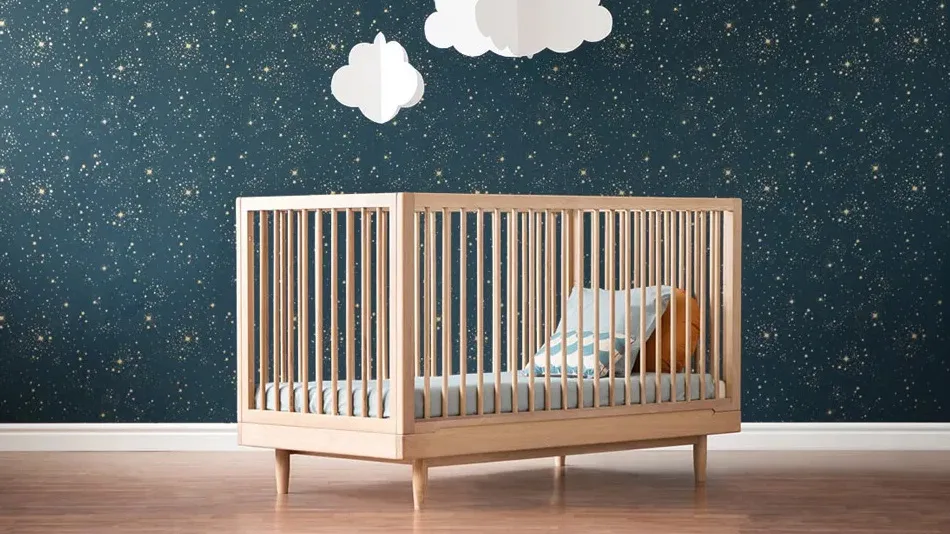
Firmness and support - what your baby needs
Forget what you know about comfortable mattresses—baby mattresses need to be firm. Really firm. If you think a mattress feels too hard, it’s probably just right for your little one. Pediatricians and safety organisations like Red Nose are crystal clear on this: a firm cot mattress isn't just a recommendation; it's essential for preventing suffocation risks and ensuring proper support.
Why babies need a firm mattress:
- Your baby can't move or turn their head if they sink into a soft surface
- A firm mattress gives your newborn the stable support they need for tummy time and muscle development
- Proper spinal alignment requires firm support during these crucial growth stages
- Your baby needs a solid surface to master motor skills - from rolling over to pushing up and head lifting
A good test? Press your hand into the center of the cot mattress. It should bounce back immediately and not mould to your hand shape. The ideal density should be between 20-30 kg/m³ – think of it like pressing on a dense sponge rather than a fluffy pillow.
You'll find dual-sided baby mattresses on the market, and for good reason. From birth until approximately 12-18 months, an 'extra' firm surface is recommended to ensure safe support for your baby. Around 18-24 months, this firmness may become uncomfortable. That's why some manufacturers offer reversible mattresses with a slightly softer side that better accommodates your growing child's physique while maintaining appropriate firm support for their development.
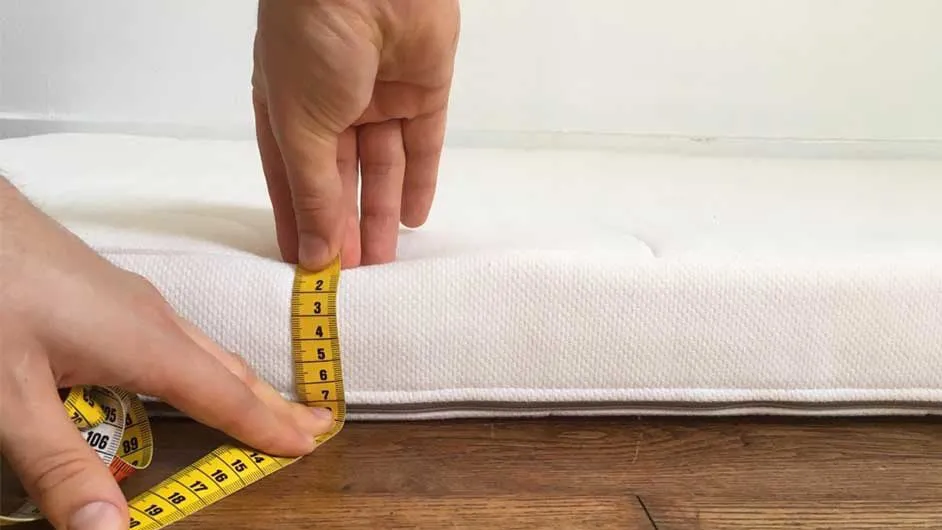
Cot mattress certifications explained
Most parents don't realise your infant's first three years are crucial for developing their immune and respiratory systems. During this time, they're like tiny sponges - absorbing everything from their environment, including things we can't see.
Your newborn spends most of its time sleeping, breathing just inches away from its mattress. Volatile Organic Compounds (VOCs) and endocrine disruptors, invisible chemicals released from synthetic materials, can irritate tiny lungs, trigger allergic reactions, and interfere with hormonal development.
The certifications that guarantee peace of mind:
- OEKO-TEX® Standard 100: Guarantees no harmful chemicals in textiles
- GOTS: The gold standard for organic materials
- CertiPUR: Essential if you're buying foam, ensures low VOC emissions
“As someone who developed asthma early in life, I've learned firsthand how early exposure to synthetic materials can affect long-term health. “
This is why it's better to choose a natural or organic cot mattress, like those made from latex, coconut Coir, or natural fibre foam. These mattresses are free from harmful chemicals and provide a healthier sleep environment.
Natural materials matter beyond the mattress—pyjamas, bedding, and toys also contribute to your child’s environment. Just like you wouldn’t feed your baby processed food full of additives, you shouldn’t let them sleep on synthetic materials full of chemicals.
Think of it this way: you wouldn't feed your baby processed food full of chemicals, so why let them sleep on synthetic materials full of them?
The truth about "Antibacterial", “Hypoallergenic” treatments
Some companies push hypoallergenic, antibacterial treatments as a safety feature, but here's the reality: they're adding unnecessary chemicals like triclosan and formaldehyde to your baby's mattress. These treatments not only expose your little one to endocrine disruptors but also need regular renewal - meaning more chemical exposure over time.
Nature does it better: materials like wool, coconut fibre, and natural latex have inherent anti-bacterial properties without chemical treatments. These materials naturally resist bacteria and dust mites while keeping your baby safe from harmful additives. If you're concerned about bacteria, choose these natural alternatives: baby mattresses instead of chemically treated surfaces.
So forget the fancy marketing jargon - if you see words like "revolutionary sleep-tech foam" or "advanced bacterial shield cover" instead of simple, natural materials you can pronounce, just walk away. Your baby doesn't need a mattress that sounds like it belongs in a sci-fi movie.
Temperature Regulation - beyond just "Keeping Cool"
Temperature regulation in a baby mattress isn't just about the surface - it's about layers. Most budget mattresses use a single layer of synthetic foam that traps heat and moisture, like wrapping your baby in plastic. This creates a problematic sleep environment where your baby can quickly overheat, especially during Australian summers.
Unlike adults, who can kick off blankets when hot, babies depend entirely on their sleep surface to maintain a comfortable body temperature. That’s why the best cot mattress is made from natural materials, which excel at airflow and temperature regulation, ensuring your baby stays comfortable and safe throughout the night.
Best cover materials:
- Organic cotton – Naturally breathable and moisture-wicking.
- Wool – Regulates temperature year-round.
- Bamboofibress – Sustainable and excellent for moisture control.
- Tencel/Lyocell – A modern plant-based fibre superior to synthetic alternatives.
For covers, avoid polyester, which traps heat and releases microplastics; chemically treated "cooling" fabrics full of synthetic additives; and PVC-coated waterproof layers that can off-gas harmful chemicals.
Best core materials:
- Natural latex layers – Allow airflow while maintaining support.
- Coconut coir – Creates natural ventilation channels.
- Cotton or wool padding layers – Disperse heat naturally.
- Pocket springs – Enhance breathability with air pockets.
Avoid memory foam and polyurethane foam for the mattress's core. They trap heat, don’t breathe well, and often contain chemical cooling agents like gel beads.
As mentioned in our preview reviews in the recommendation, Ecosa and Airnest use a new technology featuring rigid polyethylene with a highly breathable design composition, particularly Airnest, which extends this concept all the way to the cover. It's true that in terms of airflow and temperature regulation, they perform equivalently or even better than some natural materials, but the fact remains - they're still plastic. While their temperature regulation properties may be impressive, parents should consider whether having their baby sleep on a synthetic surface, regardless of how well it manages airflow.
Remember: Babies can't regulate their temperature as well as adults. A cot mattress that combines poor temperature regulation with synthetic materials creates a double risk: uncomfortable sleep and unnecessary chemical exposure during these crucial developmental years.
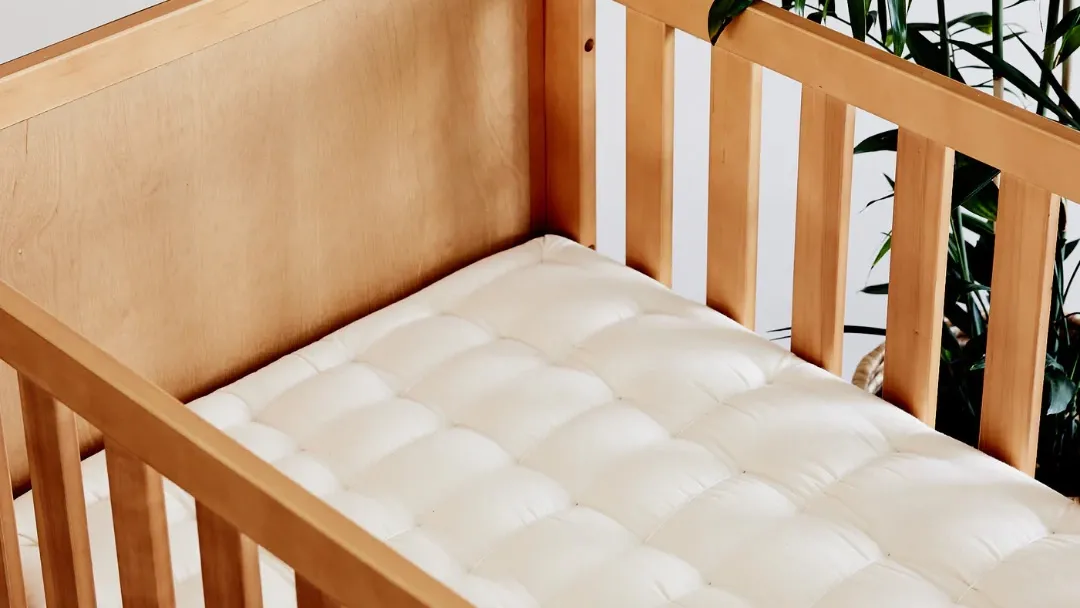
Why you need to protect your cot mattress with a mattress protector
Let's be honest: When it comes to hygiene, a removable cover for your baby's mattress isn't just a luxury; it's essential. Yet many natural mattresses don't include a removable zippered cover, and this choice is typically motivated by a simple reason: incorporating a zipper often requires adding synthetic materials or chemical treatments to ensure its durability and resistance.
This doesn't mean natural cot mattresses are difficult to maintain. Instead of relying on potentially zippered covers, experts recommend a layered approach: a fitted organic cotton protector (or any natural protector) plus a high-quality natural fibre sheet. This creates a complete protection system that prioritises both hygiene and environmental responsibility.
The beauty of this layered approach (cot mattress + protector + sheet) is its practicality for real-life parenting. You can wash individual layers more frequently and always have clean backups ready - a game-changer for those inevitable nighttime accidents. Any parent who's dealt with 3 AM diaper leaks will appreciate having spare, clean layers on hand rather than waiting for a single zippered cover to wash and dry.
Ensure the perfect fit for comfort & safety
Most Australian cots use the standard mattress size of 130 cm x 69 cm. This size works perfectly for typical rectangular cots and will serve your child well for up to 2-3 years. However, not every family has the exact needs or space requirements.
Other Common Options:
- Compact Cot (108 cm x 53 cm): Perfect for smaller nurseries or urban living
- Large Cot (131 cm x 75 cm): Ideal for bigger babies or if you're planning long-term use
- Travel Cot: These come with their special sizes, often designed to fold or split for portability
Before you buy, consider how long you plan to use the cot. A standard size might be perfect if you're considering transitioning to a toddler bed or single kid's mattress around age 2 or 3. But if you want something that'll last longer, you might want to look at larger options.
When it comes to mattress fit, there's zero wiggle room. Red Nose experts put it plainly: You should never see more than a 20mm gap between your mattress and cot frame. This precise measurement isn't just a suggestion—it's a vital safety requirement for your infant's sleep space.

How much does a cot mattress cost in Australia?
You'll find baby mattresses at every price point in Australia - from $80 budget options at Kmart and Big W to premium choices over $800. While those sub-$100 mattresses might tempt your wallet, they often use the cheapest synthetic materials and minimal safety testing. The sweet spot for a quality cot mattress typically sits around $500, where you'll find better materials and safety certifications.
Why you should never buy a second-hand mattress
Here at True Dream, we strongly advocate for sustainability and second-hand purchases - but cot mattresses are an absolute exception. Here's why:
- Invisible damage: Dips and soft spots can compromise the crucial firm support your baby needs
- Hidden nasties: Even thorough cleaning can't eliminate deep-set mould, bacteria, or dust mites
- Unknown history: You can't know about accidents, storage conditions, or pest issues
- Chemical build-up: Old mattresses might contain banned substances or break down over time
Are IKEA cot mattresses safe?
Oh, IKEA - we love your meatballs and maze-like stores, but when it comes to cot mattresses? Let's have a heart-to-heart. While their prices might make your wallet smile (looking at you, PELLEPLUTT at $75 or JÄTTETRÖTT at $149), there's a catch bigger than trying to pronounce these Swedish names correctly.

Here's the not-so-cozy truth: these baby mattresses are polyurethane foam wrapped in polyester. That's like dressing your Infant in plastic pyjamas and expecting them to sleep comfortably! Sure, you might save $200/300 upfront, but at what cost?
Instead of playing mattress roulette at IKEA, Big W, or Kmart, consider this: for just around $500, you can get a mattress that isn't trying to win a chemical cocktail contest. Trust us, your baby's future lungs will thank you for skipping the budget synthetic options. Sometimes, the best deals are the ones you don't take, especially regarding your little one's sleep sanctuary.
Beyond price - thinking long term
Yes, we know what you're thinking: "Why invest in an expensive mattress that will only be used for 2 or 3 years max?" It's a fair question. Investing in a quality cot mattress can feel overwhelming, especially when those first three years require specific safety standards. But here's the bigger picture: these early years set the foundation for your child's lifelong sleep health and safety.
During this critical period, choosing the best cot mattress isn't merely a matter of comfort—it’s crucial for your baby's safety. Experts emphasise the importance of breathable, natural materials and strict safety standards to significantly reduce risks associated with infant sleep, such as suffocation or overheating.
Rather than viewing it as a short-term expense, think of it as a foundational investment in your child’s development, health, and future. For approximately $1,000, you can ensure a completely non-toxic sleep environment—including a high-quality mattress, organic protectors, and breathable natural fibre sheets—that safely supports your baby throughout the entire cot phase.
Moreover, unlike lower-quality cot mattresses, a premium natural mattress can remain in excellent condition well beyond these early years, making it reusable for siblings or family members (don't forget you should only reuse it if you've protected the mattress correctly), thus extending its practical lifespan and value.
If budget constraints force you to prioritise, invest where it truly matters: your child's safety, health, and sleep quality. After all, what better gift could you offer your child than the healthiest possible start in life?
A final note on SIDS
We've chosen to place this section at the end of our article because, while it's not pleasant to discuss, it's crucial information that could save lives.
Red Nose reports that 106 babies died from SUDI across Australia in 2022. While many of these cases were classified as unknown causes, research shows that most could have been prevented through safe sleep practices. This reinforces why proper sleep safety is so crucial for our little ones.
The Non-Negotiable Sleep Safety Guidelines
- Always place your baby on their back to sleep during their first year
- Use a sleep bag or wearable blanket instead of loose bedding
- Ensure the mattress is firm enough to prevent your baby from rolling or getting trapped
- Keep the cot clear - no pillows, quilts, blankets, toys, or cot bumpers
- Never let your baby sleep with a hat on indoors
After their first birthday, babies typically develop the strength and mobility to adjust their position safely if needed. However, maintaining a safe sleep environment remains important throughout early childhood.
"While these guidelines might seem overly cautious, they've helped save thousands of lives. When in doubt, remember: bare is best - just your little one, their sleep bag, and a firm mattress in a properly fitted cot."


